SUMMARY
This is AI generated summarization, which may have errors. For context, always refer to the full article.
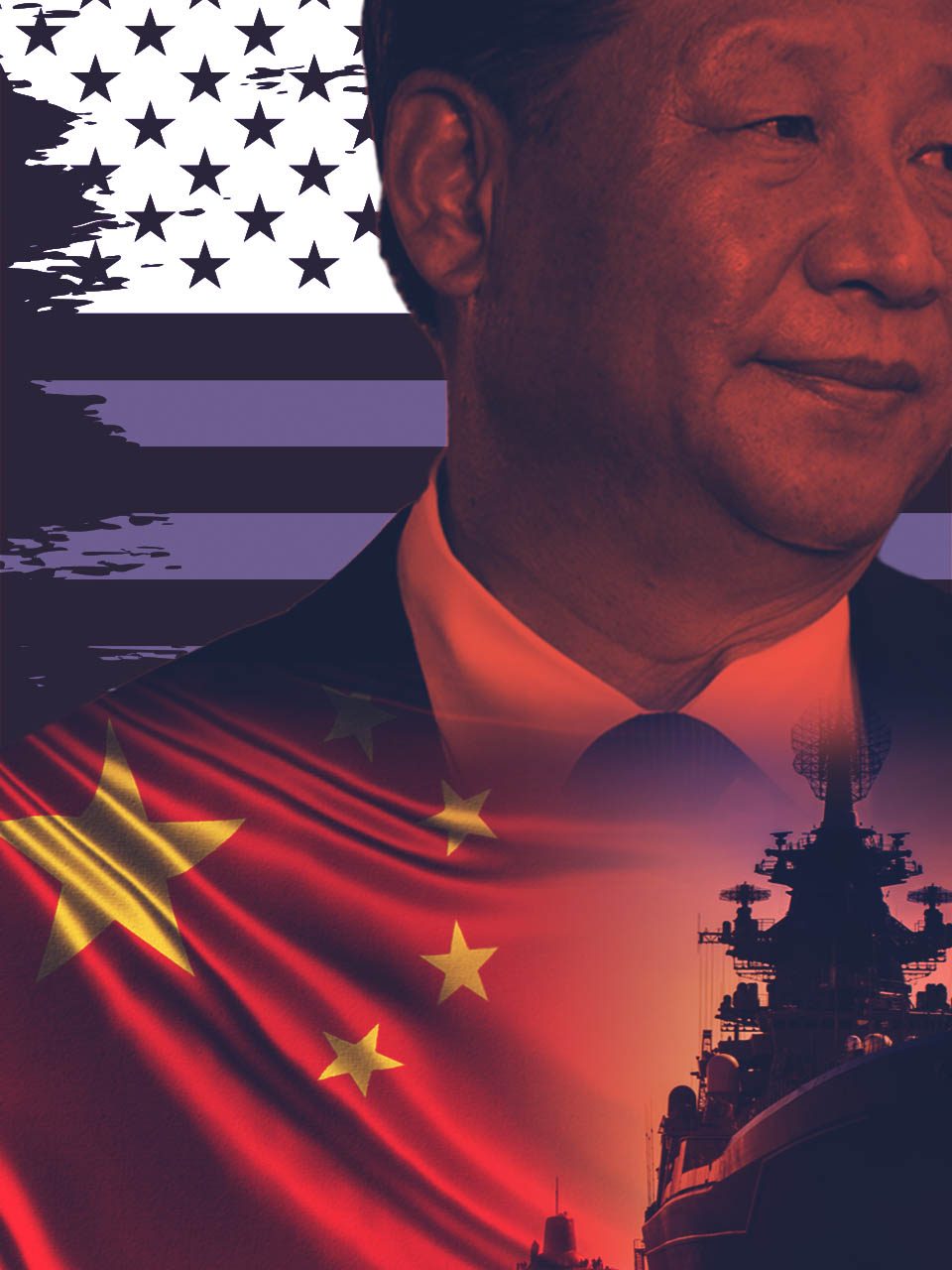
China is arguably one of the growth miracles of the late 20th century and early 21st century. In 2017, the Chinese economy was estimated to be as large as $12.24 trillion, the second largest in the world and in fact poised to overtake the US economy as the world’s largest.
This incredible prospect is borne by decades of impressive economic growth. Based on official data from the Chinese government, economic growth skyrocketed to almost 16% annually in the early 1990s, and this rose again to almost 15% around 2008 right before the global financial crisis.
Even as China is poised to over take the US as the world’s largest economy, China is losing steam, slowly but surely.
China’s GDP losing steam
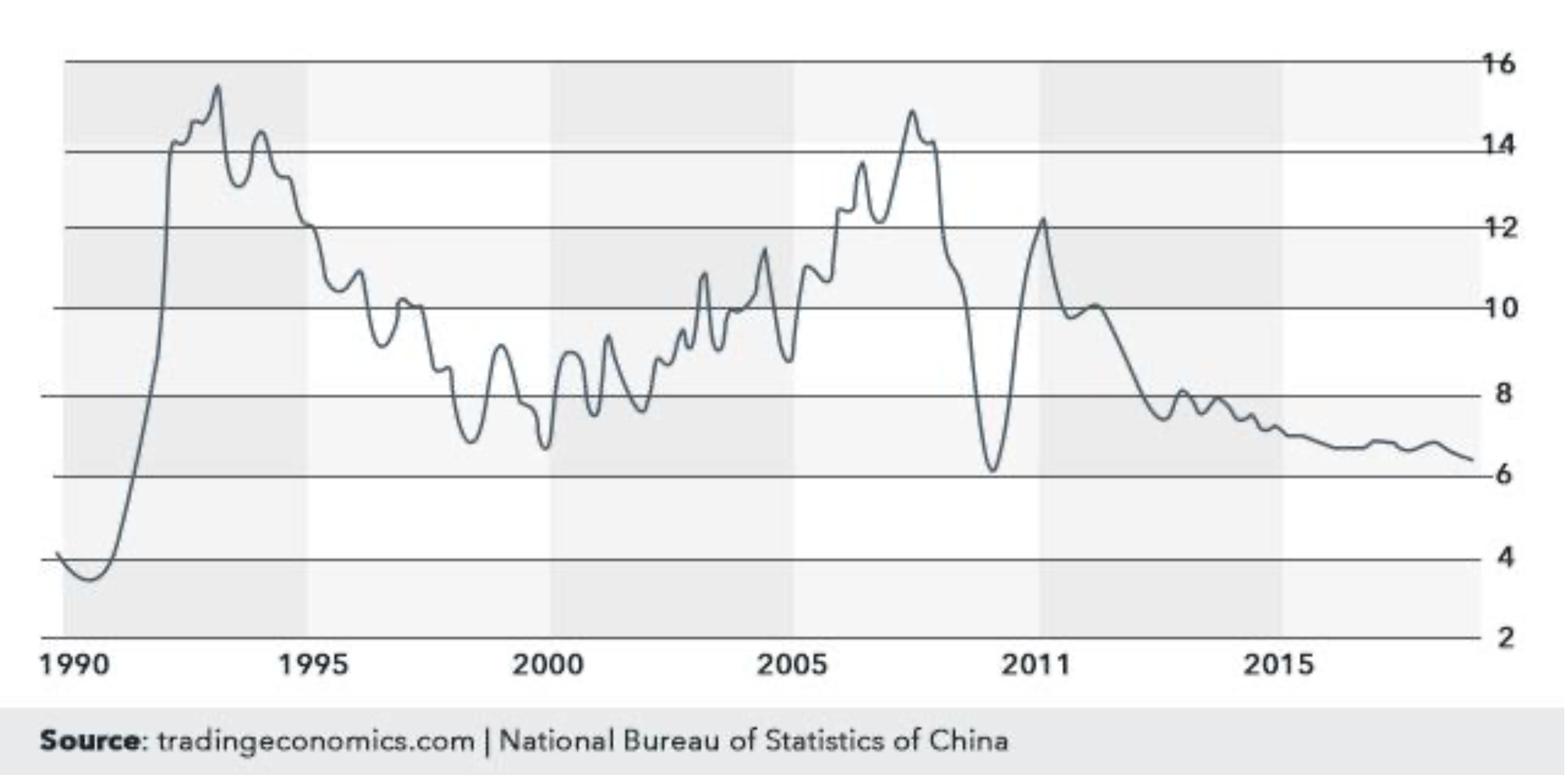
There are, of course, doubts as to the accuracy of China’s national income accounts. In fact, a recent Brookings Report reported updated figures to this end, saying gross domestic product (GDP) growth figures from 2008 to 2016 may have been 1.7 percentage points lower than official data released by China’s National Bureau of Statistics. At the same time, the investment and savings rate in 2016 was as much as 7 percentage points lower than official figures.
Notwithstanding these discrepant numbers, it is apparent that Chinese economic growth is slowing down. Annual growth in 2018, based on official sources, was a mere 6.6%, a far cry from the levels before the Global Recession, and in fact, the slowest in 28 years
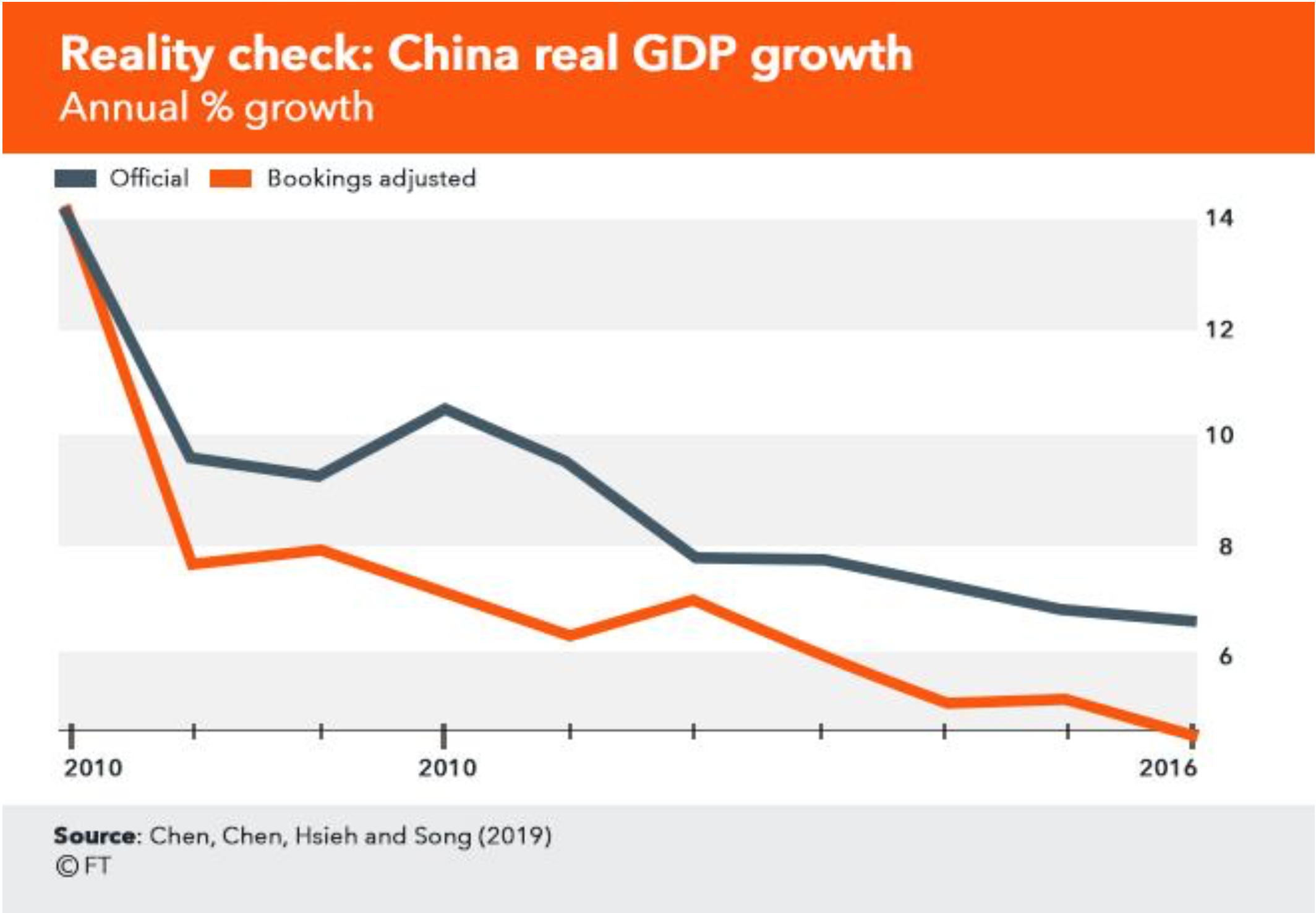
Slower growth has led some economists to say that China may currently be ensnared by the so- called middle-income trap to refer to economies stuck to a middling level of per-capita income because of poor innovation or policies that stifle future growth.
Widening inequality
There are around 500 million people living in extreme poverty in China, according to the World Bank. The International Monetary Fund (IMF) said in 2018 that while two decades of economic growth in China have raised incomes dramatically and lifted millions of people out of poverty, growth hasn’t benefited all segments of the population equally. In fact, the IMF said China has moved from being moderately unequal in 1990 to being one of the world’s most unequal countries.
A chart by the IMF shows that the Gini coefficient, a widely used measure of income inequality, has risen by 15 points since 1990 to 50. A reading of zero would indicate that everyone has the same income, while a reading of 100 would mean that the richest person gets all the income. Despite the large increase in income inequality, the IMF noted that much of China’s population has experienced rising real incomes. The IMF said that China lifted people out of extreme poverty immensely, with poverty rates decreasing by 86 percentage points from 1980 to 2013, the most rapid reduction in history.
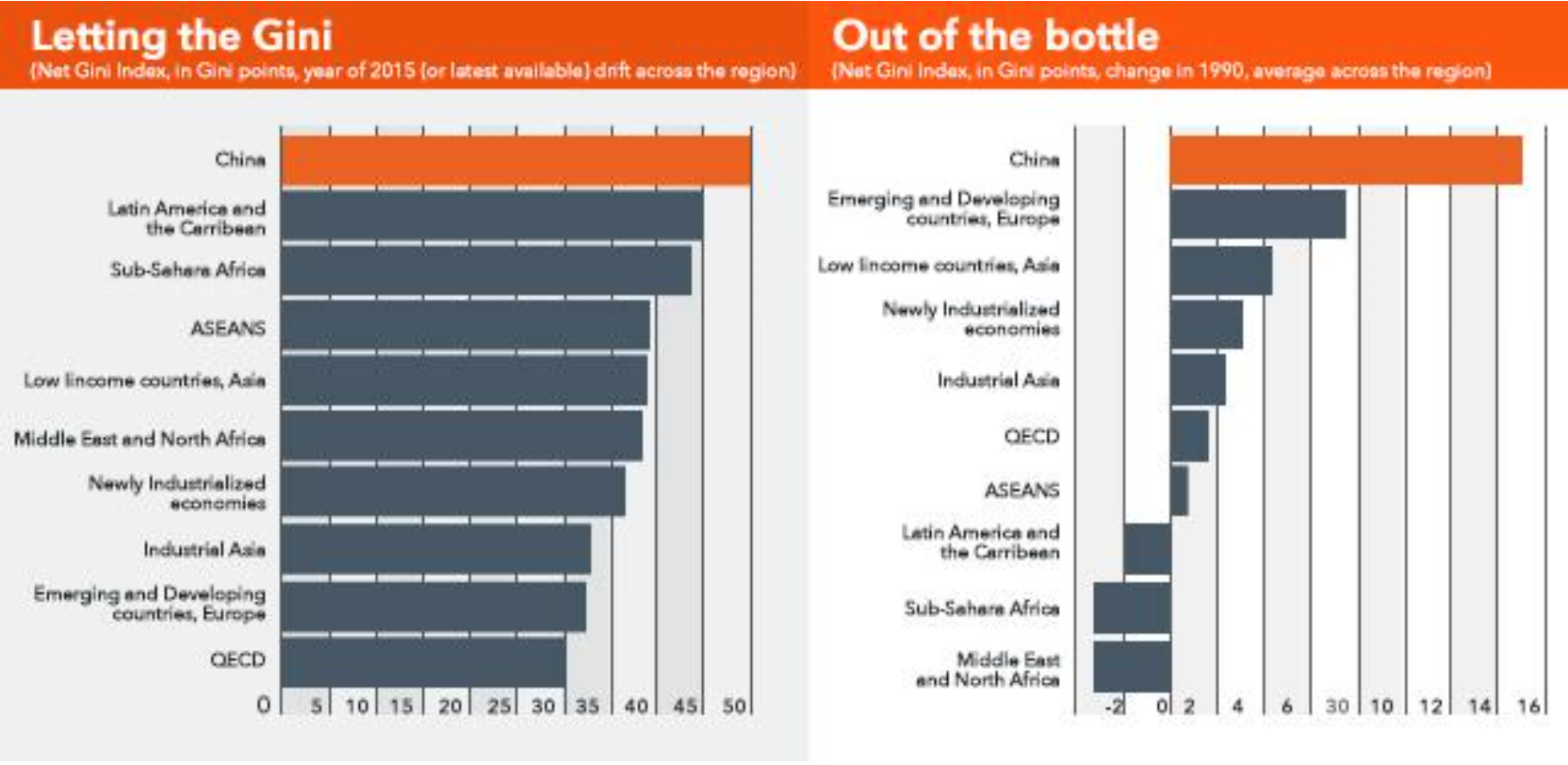
Despite the progress, the IMF also noted that China faces great inequality in opportunities, such as completion of higher tertiary education. The gaps are even more visible when compared to regional, rural-urban, and wealth differences. China also lags in major advanced economies in terms of financial inclusion. While access to financial services increased with regards to internet and mobile-based payments, China still lags in the basics, particularly in borrowing and other transaction services.
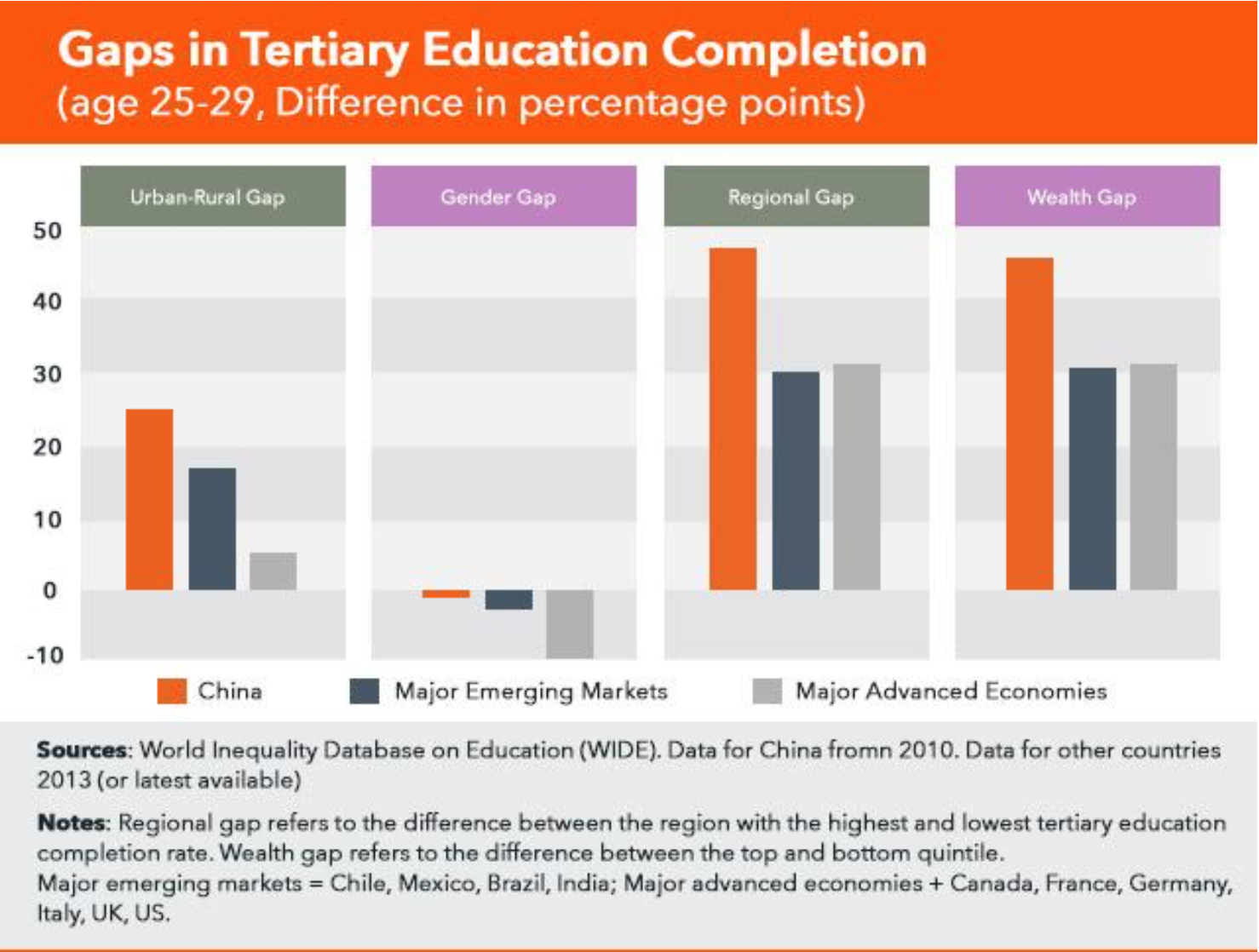
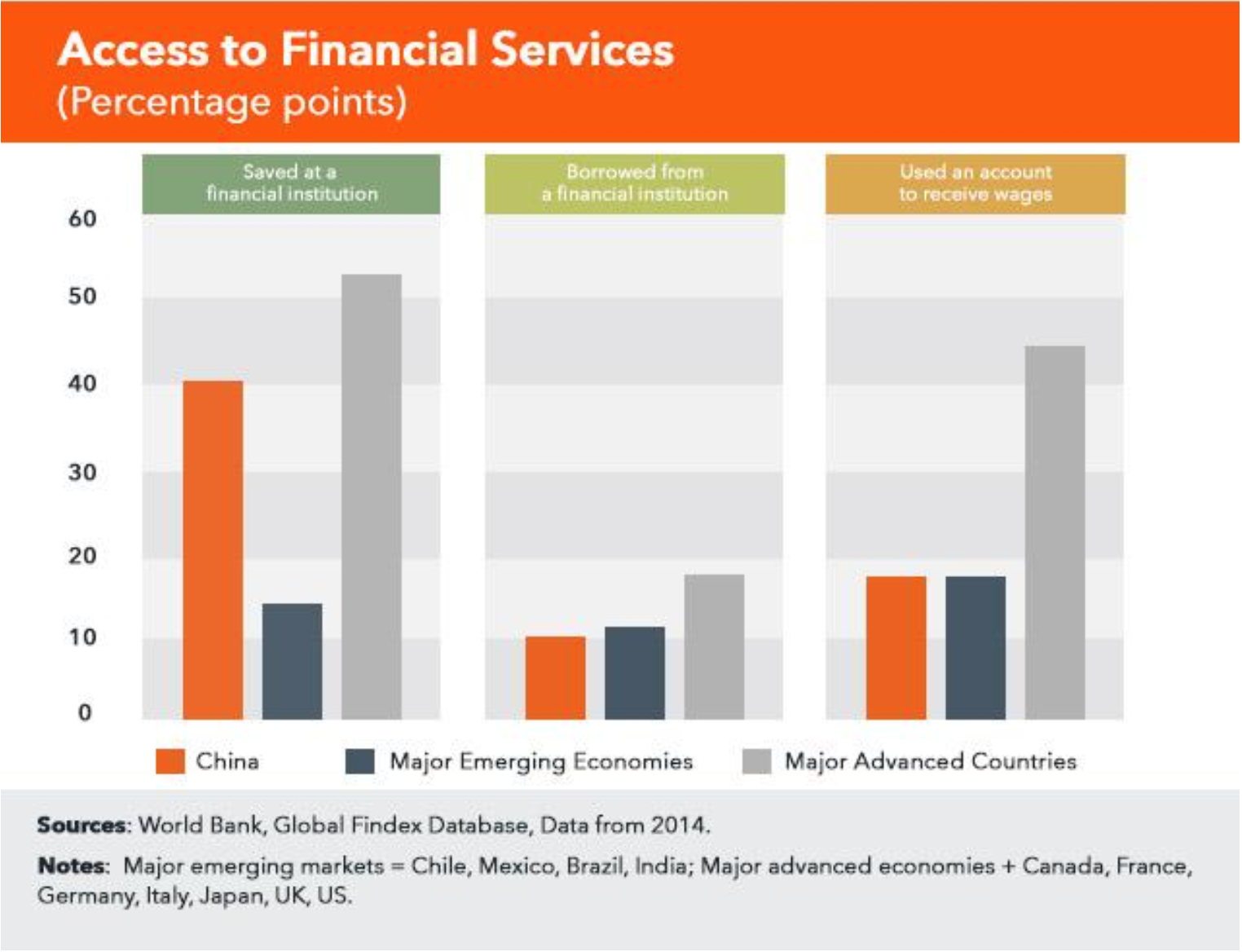
Demographic winter
China’s population is also aging rapidly. According to a TIME report (quoting a study by the Chinese Academy of Social Sciences) China’s population is projected to peak at 1.44 billion in 2029 before declining steadily. At the same time, the old-age dependency ratio is also projected to rise steadily. One major culprit is China’s one-child policy which ran for 36 years before being abolished in 2015. The discrimination it engendered led to a conspicuous imbalance in China’s sex ratio and the 62 million “missing” women, but now its impact is felt in the country’s declining birth rates.
These demographic trends are expected to bear upon not only China’s retirement and healthcare sectors but also – more importantly – on the country’s productive capacity and output growth. A trickling entry of young people in the labor market, combined with the increasing need to provide for old parents and grandparents, is certainly going to strain China’s workforce already beleaguered by the fourth industrial revolution and the wave of creative destruction it threatens to bring.
Moreover, the Chinese Academy of Social Sciences warned that the negative impact of a declining birth rate would be felt in 2027. Other researchers, however, believe it has already begun.
The Belt and Road Initiative
China’s weakening economy comes at a time when its foreign policy is also strengthening as embodied by the Belt and Road Initiative (BRI). BRI, the brainchild of President Xi Jinping, who first proposed it in 2013, is an ambitious global project to bolster China’s economic and political ties across 65 countries in Asia, Africa, and Europe, representing about 30% of global GDP, 62% of the global human population, and 75% of global energy reserves.
The chart below shows that BRI comprises two main corridors: the Silk Road Economic Belt (which establishes road and rail links across Central and South Asia toward the Middle East and Europe), and the New Maritime Silk Road (which establishes shipping routes spanning Southeast Asia, the Indian Ocean, all the way to Africa and Europe).
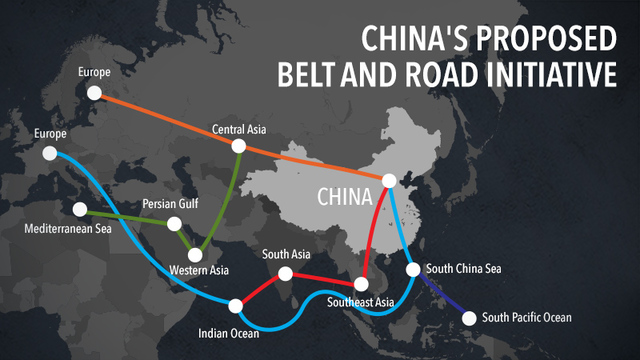
Funding for BRI comes largely from the tremendous growth of China’s current account especially in the 2000s, borne by tremendous exports vis-à-vis imports.
Although BRI focuses mainly on establishing physical infrastructure links (e.g., roads, ports, airports, pipelines, dams, railways) it also – arguably more saliently – focuses on establishing institutional and policy links with the countries participating in BRI.
On the one hand, the BRI presents an opportunity to boost economic growth not just for China but also for the many developing countries riding on it. A global breakdown of trade and investment barriers between China and the rest of the world is expected to prop up floundering Chinese growth.
Africa, for example, has benefitted immensely from BRI: China has already built international airports in Djibouti, industrial zones in Ethiopia, and railways in Kenya and Nigeria. From 2000 to 2015, Chinese loans to Sub-Saharan African countries grew by 98 times, reaching a peak of $17 billion in 2013. A study by the RAND Corporation found that constructing more transport infrastructure in the BRI regions led to improved bilateral trade, and between them there exists a positive and statistically significant correlation.
On the other hand, China’s tremendous global expansion via the BRI has raised concerns about “neocolonialism”: that despite its ostensibly economic rationale, the BRI is really a way for China to plant itself firmly in the local politics of its partner countries. Increasingly many countries are finding themselves ensnared by China’s so-called “debt-trap diplomacy,” unable to pay the loans they acquired from Beijing in the context of BRI. Once unable to pay, these countries end up with no choice but to surrender patrimonial assets (mostly natural resources) or other strategic state assets, often compromising their sovereignty and national security stance. Here are some examples:
- In February 2018, China sent 11 warships in the East Indian Ocean while a constitutional crisis raged in the Maldives. Maldives owes China at least $2 billion in loans, and China and India are reportedly vying for influence over the island chain.
- In December 2017, Sri Lanka was forced to give China a 99-year lease on its strategic Hambantota port after failing to pay its debts. The port city of Mombasa in Kenya might suffer the same fate after China funded a $3.8-billion railway there.
- In 2017, Djibouti allowed the construction of China’s first overseas military base on top of having paid China $20 million per year for its outstanding debts.
- In 2016, Ecuador opened a new hydroelectric dam called Coca Coda Sinclair. Funded and built by the Chinese, the dam is perilously built near an active volcano and is covered in thousands of cracks only two years since it opened. The project was financed by an onerous loan from China totaling $1.68 billion, payable in 15 years, and with a 7% interest rate. Ecuador repays this and other loans by giving up 80% of its oil resources to China.
- Venezuela, now in the throes of economic crisis, also borrowed $63 billion from China between 2007 and 2014. China insisted that Venezuela repay it with oil.
- Turkmenistan has also given China access to its natural gas supplies after encountering similar debt troubles.
Chinese debt trap already in the Philippines?
The BRI garners mixed reviews, with the negatives gaining traction due to the political and legal implications. However, the Philippine government seems to be seeing more of the upsides. The Philippines signed a memorandum of understanding (MOU) with China supporting the BRI in 2018. In the MOU, the Philippines and China agree to hold “regular dialogue” on “key macroeconomic policies and development strategies” and will work side by side on sectors like infrastructure, transportation, telecommunications, energy, and “other areas of mutual interest.” The two also agreed to expand the use of local currencies in two-way trade and investment. A “cooperation mechanism” is established to deal with financial risk and crisis.
While there are no ports directly linking the Philippines to the BRI, various big-ticket infrastructure projects funded by China have started construction, and more are in the pipeline. These projects, in general, still serve the interests of China and can be viewed as part and parcel of the BRI.
So far, the Philippines has secured Chinese credit for 4 construction projects. The Philippines got for free the Binondo-Intramuros and Estrella-Pantaleon Bridges through a $63-million grant. Meanwhile, the ones that were financed through Official Development Assistance (ODA) were the $52-million Chico River Pump Irrigation Project and the $211-million New Centennial Water Source-Kaliwa Dam project.

The Subic-Clark Railway Project in Luzon ($50 billion), Mindanao Railway Project (over $106 billion), Davao-Samal Bridge Project ($9 billion) and the Panay-Guimaras-Negros Inter-island Bridge Project ($27 billion) are being considered for Chinese funding. With all these rather pricey projects, is the Philippines in danger of falling into the Chinese debt trap? So far, the debate of experts and the government’s economic team has been quite heated on the matter.
Progressive groups have already raised the alarm over the “onerous” loan terms of the Chico River and Kaliwa Dam projects. No less than Senior Associate Justice Antonio Carpio, the most senior among all justices in terms of years served in the judiciary, pointed out the possibility of the Philippines giving up patrimonial assets like gas in the contested Recto Bank (Reed Bank) in the West Philippine Sea.
However, the Department of Finance (DOF) insisted that the clauses in the loan agreements were simply “standard” in any government-to-government contracts. DOF officials said the terms just meant that the Philippines agreed to be subject to arbitration in case problems arise, including the extreme case of loan default. The agency even went on to explain that some of the terms critics called onerous were present in other contracts the previous administrations signed with other countries.
In terms of total loan exposure, loans from China stood at only 0.66% of the country’s total debt, much lower than other countries like Japan, which is at 9%. By 2022, the country’s project debt to China will account for 4.5% of the total debt, while that of Japan’s will be twice as large at 9.5%, according to finance chief Carlos Dominguez III.
Meanwhile, the country’s debt-to-gross domestic product (GDP) ratio, the figure that compares the loan obligations relative to the economy’s size, stood at 41.9% as of 2018. This figure, the economic managers claimed, is quite decent and showed the government’s prudent financials. This is expected to decrease further to 38.6% in 2022. Critics, however, also pointed out that the matter is beyond paying off debts.
The Center for Global Development came up with a list of countries most at risk from China’s debt trap based on two factors: the projected increase of the debt-to-GDP ratio and the share of debt owed to the Chinese. The list includes countries such as Djibouti, Mongolia, Montenegro, Pakistan, Kyrgyzstan, Laos, Maldives, and Tajikistan. The Philippines is not on that list because as of March 2019 China accounted for just 1.8% of all active official development assistance (ODA) loans.
For its part, the Freedom from Debt Coalition (FDC) said that some of the deals, including the Kaliwa Dam project, may not necessarily be the best. FDC said the Kaliwa Dam project has a negative environmental impact and will displace thousands of residents. Moreover, it noted that even without considering the project’s socioeconomic impact, the loan from China may have been much more pricey, as compared to other possible ODA sources.
Chinese construction workers?
On top of the heated debate on the financing terms, critics also pointed out that China-funded projects seemed to favor foreigners over local workers. Various news outlets have shown videos of Chinese workers mixing cement and doing tasks of construction workers in some of the big- ticket infrastructure projects.
Labor group Associated Labor Unions-Trade Union Congress of the Philippines pointed out in an ABS-CBN report that Filipinos are losing opportunities to work due to the situation. The
Chinese site manager said in the report all workers had the necessary permits to work and possess technical expertise, which the Filipino workers did not.
The Department of Labor and Employment (DOLE) has emphasized that foreign workers are not allowed in jobs that can be done by Filipinos, such as those in construction. Only foreigners who have highly-specialized skills are allowed to work in the country.
From Rappler’s own investigation, it remains inconclusive whether or not the Chinese have indeed taken away jobs. However, we found that there are lapses on how foreign workers obtain the necessary papers to work in the country. Based on a Senate investigation held last November 2018, there are two ways for foreigners to work in the Philippines.
- DOLE can issue alien employment permits or AEPs. Around 52,000 Chinese have obtained AEPs.
- The Bureau of Immigration (BI) can issue special employment visas for foreign workers, without the need for AEPs. The agency issued some 119,000 special visas in 2018.
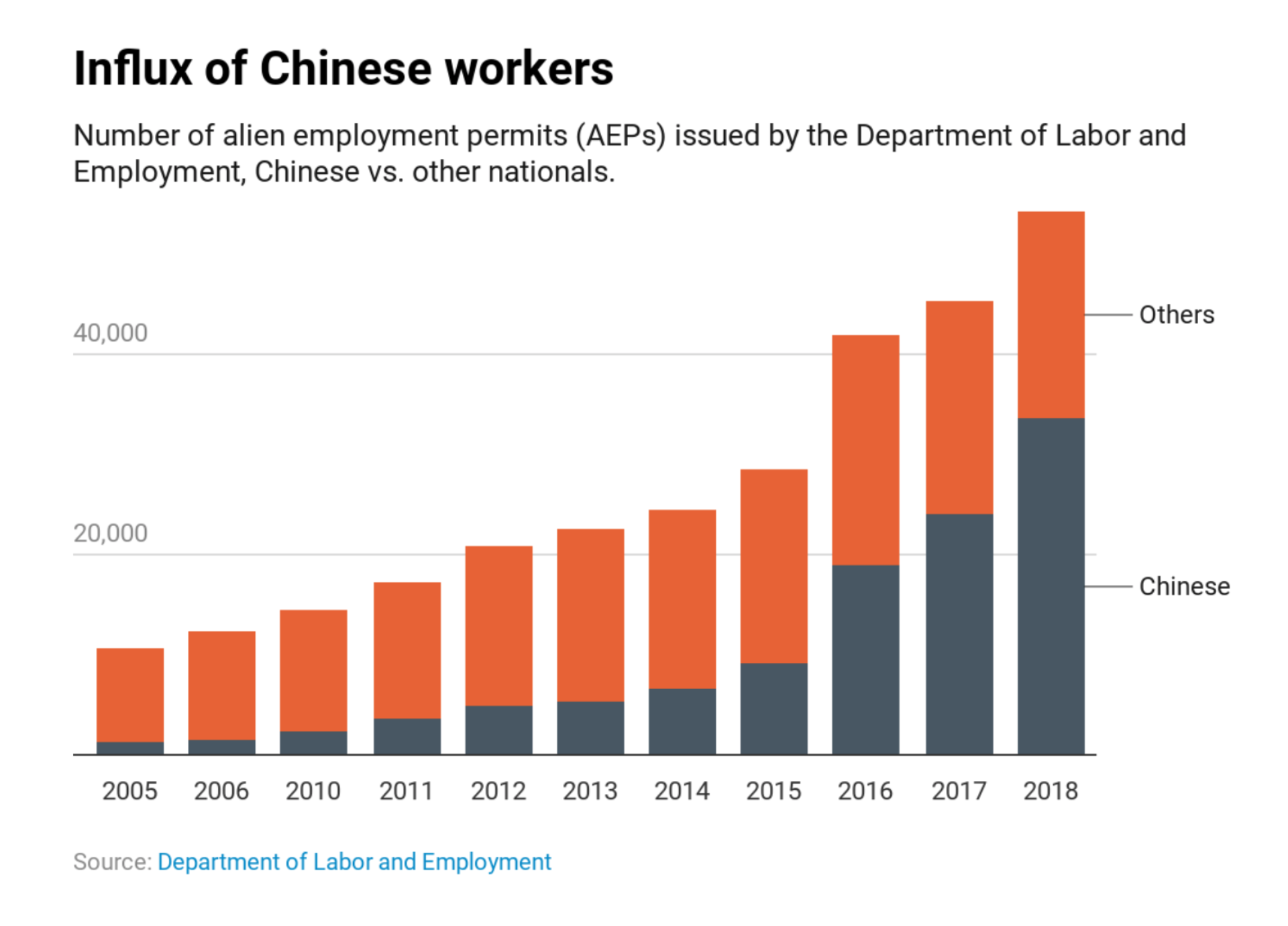
- Senators said the BI is not the appropriate agency to assess whether or not foreigners can be employed in the Philippines. Due to the controversies over the employment of Chinese citizens, Senator Sherwin Gatchalian proposed to amend Republic Act 8182 to strictly require foreign contract holders from ODA donor countries to hire local workers for blue-collar jobs.
The country’s top economist, Socioeconomic Planning Secretary Ernesto Pernia, warned that ODA partners like China may not be amenable to the proposal. “It depends on the ODA country. Japan will probably be more agreeable, but China will probably need some negotiations, hard bargaining,” Pernia said.
Private Chinese investments
It’s not just the Chinese government warming up to the Philippines. Private companies have also started to cozy up and have invested in various sectors in the country. Looking at data from the Bangko Sentral ng Pilipinas (BSP), foreign direct investments (FDIs) from China remain relatively low compared to other countries like the United States and Japan, but these have started to gain traction under Duterte’s presidency.
In 2018, Chinese FDI rose to almost $200 million or P50.6 billion – the highest ever in Philippine history.
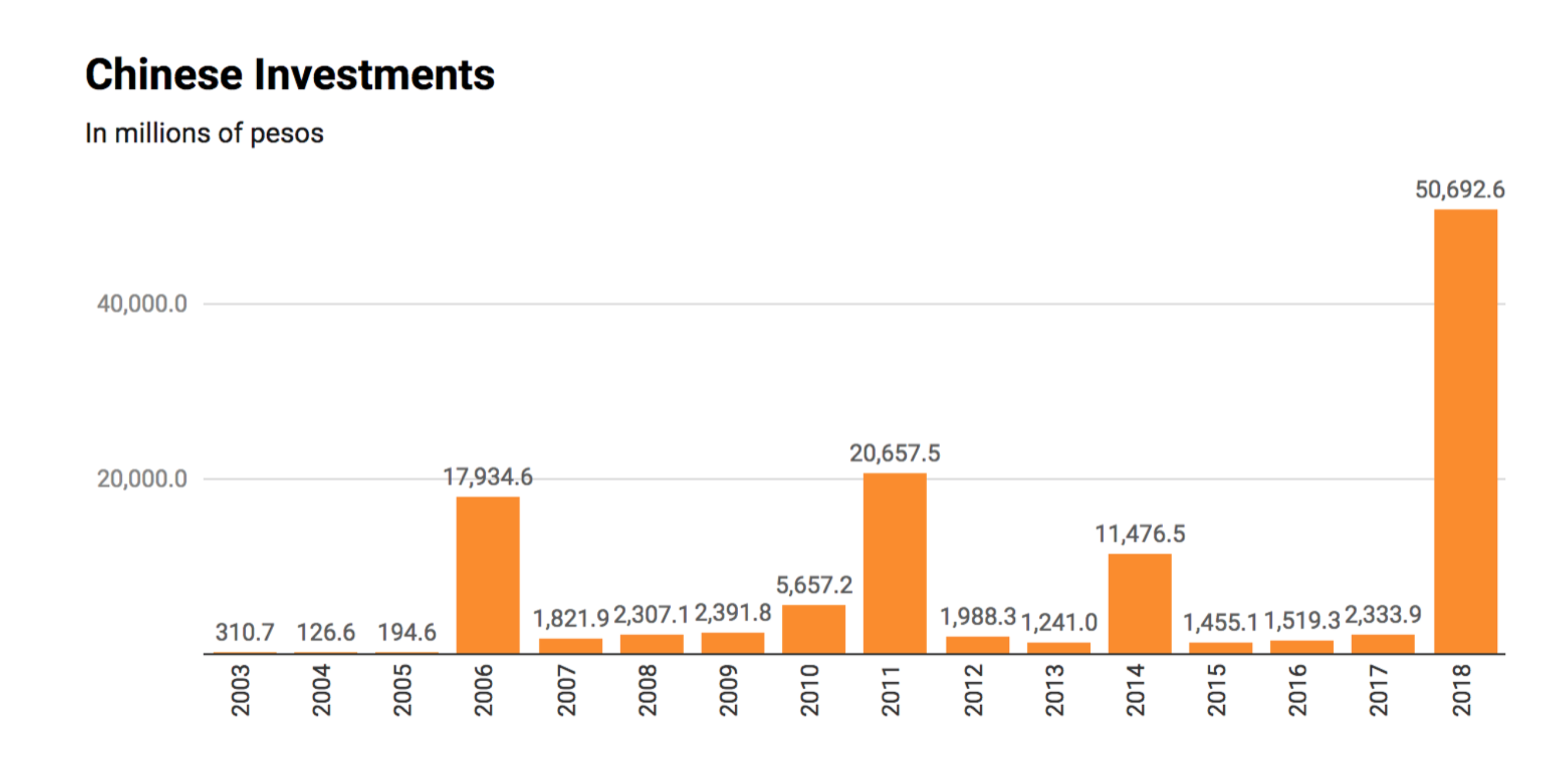
The number of firms with Chinese FDI doubled under Duterte. Data from the Securities and Exchange Commission (SEC) gathered by Alvin Camba, a China Initiative Fellow at the Global Development Policy Center, showed that from around 500 to 600 firms, the Philippines now has some 1,257 under Duterte. However, he also said in his study published by the Philippine Center for Investigative Journalism, the rise of Chinese FDI started during the presidency of Benigno Aquino III, indicating that the disputes in the West Philippine Sea did not disrupt the economic relationship of private Chinese and Filipino businessmen.
Camba argued that the economic growth during the Aquino administration, as well as external factors affecting China, pushed Beijing to diversify its investment portfolio. “Another way of putting it is that the economic relations and motivations between Filipino and Chinese citizens, perceived improved Philippine economy during the Aquino III administration, and inertia of economic reforms since the 1990s accounted for the rise of Chinese FDI,” Camba said.

“Nonetheless, Aquino III’s conflictual relations with China in the West Philippine Sea and his somewhat negative treatment of some Chinese investments affected potential investments. In truth, one can argue that Chinese investments increased not because, but in spite, of Aquino’s policies,” he added.
Camba also found that Chinese investments, or companies in which the Chinese have at least a 10% stake, showed that Metro Manila, Central Luzon, Calabarzon, Central Visayas, and the Davao del Sur region received the highest shares. Makati has a total of 426 firms, while Taguig City has a total of 100. Pasig and Mandaluyong collectively have 268, while the Eastwood district has 71. Quezon City, the largest city in terms of land area and population size, has 645 firms. The historically-Chinese district Binondo has 520 firms in total. The top 5 sectors Chinese investments are in wholesale and retail, business activities, real estate, light manufacturing, and financial holdings.
Flexible, “corrosive” capital
Aside from the Philippine economy’s robust growth-enticing investments, Chinese businessmen are also investing outside the mainland to escape the clutches of the communist party. Calla Weimer, an economics professor at the University of the Philippines who also taught in China, said that legitimate Chinese businesses are crawling out of the mainland due to rampant corruption and the government’s overly intrusive nature.
“For you to grow your business there, you need to know people and pay them off. They do not operate in a competitive environment, they operate with very close relationships with government officials,” Weimer said. Moreover, according to Weimer, the Chinese government is trying to centralize all of the money in its economy and sell it somewhere else for the benefit of the state. The said initiative, of course, is called the BRI.
Camba called private investments trying to get away from the Chinese government’s hold as “flexible capital.” He explained: “Flexible capital is the amount of money in the hands of Chinese private actors, private elites, who are trying to escape the government regulations and other issues, and therefore they export money by laundering their money or putting their money in seemingly profitable ventures such as the Philippine offshore gambling sector.”
The Chinese government is failing in keeping both legal and illegal businesses within its jurisdictions.
Weimer, as well as other scholars looking into the Chinese economy and government, said that given the massive population of over 1.4 billion, governed by around a million officials, a leak is inevitable. “All the surveillance, the seemingly harsh crackdown, it does not present the whole picture,” Weimer said.
According to Camba, the current iterations of flexible capital going in the country can be considered “corrosive,” or “bypasses and transforms” pre-existing procedures and is concentrated in specific groups. Corrosive capital also strengthens and generates new patronage networks in the Philippines.
With the points raised by experts, it seems that Chinese investments also have added, unintended, and unwanted add-ons.
(To be continued: Part 2: Online gambling and the case of the Philippines)
You can read the introduction here: The socio-economic impact of China on the Philippines
Add a comment
How does this make you feel?





![[PANOORIN] Paninindigan ng mga sibilyan sa Pag-asa Island](https://www.rappler.com/tachyon/2024/05/TITLECARD-1.png?resize=257%2C257&crop=421px%2C0px%2C1080px%2C1080px)

![[Judgment Call] Philippine seas and a healthy dose of transparency](https://www.rappler.com/tachyon/2024/05/judgement-call-ayungin-shoal-may-16-2024.jpg?resize=257%2C257&crop=316px%2C0px%2C720px%2C720px)
![[Rappler Investigates] Deal or no deal, Duterte?](https://www.rappler.com/tachyon/2024/05/deal-or-no-deal-duterte-may-16-2024.jpg?resize=257%2C257&crop=422px%2C0px%2C1080px%2C1080px)

There are no comments yet. Add your comment to start the conversation.